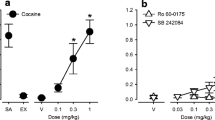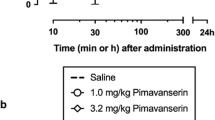Abstract
Rationale.
Serotonin (5-HT) systems may play a role in modulating cocaine-seeking behavior.
Objectives.
The present study examined the effects of acute administration of the 5-HT reuptake inhibitor (SRI) fluoxetine, and the SRI/releaser d-fenfluramine, on reinstatement of extinguished cocaine-seeking behavior elicited by either response-contingent presentations of cocaine-paired cues or cocaine priming.
Methods.
Separate groups of rats that had been trained to press a lever for a cocaine reinforcer (0.75 mg/kg per 0.1 ml, IV) with a light/tone stimulus complex paired with each infusion underwent daily extinction sessions during which responding had no scheduled consequences (i.e. neither cocaine nor the stimulus complex was available). Subsequently, the effects of fluoxetine (0–10.0 mg/kg, IP) on extinction and cue reinstatement of extinguished cocaine-seeking behavior were examined, as well as the effects of d-fenfluramine (0–3.0 mg/kg, IP) on cue reinstatement. Additionally, dose-dependent effects of fluoxetine (0–10.0 mg/kg, IP) and d-fenfluramine (0–1.0 mg/kg, IP) on cocaine-primed (0–15.0 mg/kg, IP) reinstatement of extinguished cocaine-seeking behavior were examined.
Results.
Fluoxetine dose-dependently attenuated cocaine-seeking behavior during extinction. Both fluoxetine and d-fenfluramine dose-dependently attenuated cue-reinstated cocaine-seeking behavior. In contrast, neither drug reliably altered cocaine-seeking behavior reinstated by cocaine priming.
Conclusions.
These findings suggest that 5-HT indirect agonists effectively attenuate cocaine-seeking behavior elicited by cocaine-associated stimuli, but are much less effective in attenuating cocaine-seeking behavior elicited by cocaine priming.





Similar content being viewed by others
References
Alleweireldt AT, Weber SM, Kirschner KF, Bullock BL, Neisewander JL (2002) Blockade or stimulation of D1 dopamine receptors attenuates cue reinstatement of extinguished cocaine-seeking behavior in rats. Psychopharmacology 159:285–293
Amit Z, Smith BR, Gill K (1991) Serotonin uptake inhibitors: effects on motivated consummatory behaviors. J Clin Psychiatry 52:55–60
Baker DA, Tran-Nguyen LTL, Fuchs RA, Neisewander JL (2001) Influence of individual differences and chronic fluoxetine treatment on cocaine-seeking behavior in rats. Psychopharmacology 155:18–26
Batki SL, Manfredi LB, Jacob P, Jones RT (1993) Fluoxetine for cocaine dependence in methadone maintenance: quantitative plasma and urine cocaine/benzoylecgonine concentrations. J Clin Psychopharmacol 13:243–250
Batki SL, Washburn AM, Delucchi K, Jones RT (1996) A controlled trial of fluoxetine in crack cocaine dependence. Drug Alcohol Depend 41:137–142
Burmeister JJ, Lungren EM, Zavala AR, Schroeder BE, Neisewander JL (2002) Effects of the 5-HT1A antagonist WAY 100635 and d-fenfluramine on cocaine-seeking behavior in rats. Soc Neurosci Abstr 32, No. 805.12
Buydens-Branchey L, Branchey M, Hudson J, Rothman M, Fergeson P, McKernin C (1998) Effect of fenfluramine challenge on cocaine craving in addicted male users. Am J Addict 7:142–155
Carroll ME, France CP, Meisch RA (1981) Intravenous self-administration of etonitazene, cocaine and phencyclidine in rats during food deprivation and satiation. J Pharmacol Exp Ther 217:241–247
Carroll ME, Lac ST, Asencio M, Kragh R (1990) Fluoxetine reduces intravenous cocaine self-administration in rats. Pharmacol Biochem Behav 35:237–244
Curzon G, Gibson EL, Oluyomi AO (1997) Appetite suppression by commonly used drugs depends on 5-HT receptors but not on 5-HT availability. Trend Pharmacol Sci 18:21–25
de Wit H, Stewart J (1981) Reinstatement of cocaine-reinforced responding in the rat. Psychopharmacology 75:134–143
Di Matteo V, Cacchio M, Di Giulio C, Esposito E (2002) Role of serotonin2C receptors in the control of brain dopaminergic function. Pharmacol Biochem Behav 71:727–734
Ehrman RN, Robbins SJ, Childress AR, O'Brien CP (1992) Conditioned responses to cocaine-related stimuli in cocaine abuse patients. Psychopharmacology 107:523–529
Ehrman RN, Robbins SJ, Cornish JW, Childress AR, O'Brien CP (1996) Failure of ritanserin to block cocaine cue reactivity in humans. Drug Alcohol Depend 42:167–174
Filip M, Cunningham KA (2002) Serotonin 5-HT2C receptors in nucleus accumbens regulate expression of the hyperlocomotive and discriminative stimulus effects of cocaine. Pharmacol Biochem Behav 71:745–756
Fletcher PJ (1995) Effects of d-fenfluramine and metergoline on responding for conditioned reward and the response potentiating effect of nucleus accumbens d-amphetamine. Psychopharmacology 118:155–163
Fletcher PJ, Korth KM (1999a) RU-24969 disrupts d-amphetamine self-administration and responding for conditioned reward via stimulation of 5-HT1B receptors. Behav Pharmacology 10:183–193
Fletcher PJ, Korth KM (1999b) Activation of 5-HT1B receptors in the nucleus accumbens reduces amphetamine-induced enhancement of responding for conditioned reward. Psychopharmacology 142:165–174
Fletcher PJ, Korth KM, Chambers JW (1999) Selective destruction of brain serotonin neurons by 5,7-dihydroxytryptamine increases responding for a conditioned reward. Psychopharmacology 147:291–299
Fuchs RA, Tran-Nguyen LTL, Specio SE, Groff RS, Neisewander JL (1998) Predictive validity of the extinction/reinstatement model of drug craving. Psychopharmacology 135:151–160
Grabowski J, Rhoades H, Elk R, Swhmitz J, Davis C, Creson D, Kirby K (1995) Fluoxetine is ineffective for treatment of cocaine dependence or concurrent opiate and cocaine dependence: two placebo-controlled, double-blind trials. J Clin Psychopharmacol 15:163–174
Grottick AJ, Fletcher PJ, Higgins GA (2000) Studies to investigate the role of 5-HT2C receptors on cocaine- and food-maintained behavior. J Pharmacol Exp Ther 295:1183–1191
Jaffe JH, Cascella NG, Kumor KM, Sherer MA (1989) Cocaine-induced cocaine craving. Psychopharmacology 97:59–64
Johnson BA, Chen R, Swann AC, Schmitz J, Lesser J, Ruiz P, Johnson P, Clyde C (1997) Ritanserin in the treatment of cocaine dependence. Biol Psychiatry 42:932–940
Khroyan TV, Barrett-Larimore RL, Rowlett JK, Apealman RD (2000) Dopamine D1- and D1-like receptor mechanisms in relapse to cocaine-seeking behavior in rats. J Neurosci 22:1126–1136
Lee K, Kornetsky C (1998) Acute and chronic fluoxetine treatment decreases the sensitivity of rats to rewarding brain stimulation. Pharmacol Biochem Behav 60:539–544
Markou A, Weiss F, Gold LH, Caine SB, Schulteis G, Koob GF (1993) Animal models of drug craving. Psychopharmacology 112:163–182
McMahon LR, Filip M, Cunningham KA (2001) Differential regulation of the mesoaccumbens circuit by serotonin 5-HT2A and 5-HT2C receptors. J Neurosci 21:7781–7787
McMillen BA, Jones EA, Hill LJ, Williams HL, Bjork A, Myers RD (1993) Amperozide, a 5-HT2 antagonist, attenuates craving for cocaine in rats. Pharmacol Biochem Behav 46:125–129
Neisewander JL, Baker DA, Fuchs RA, Tran-Nguyen LTL, Palmer A, Marshall JF (2000) Fos protein expression and cocaine-seeking behavior in rats after exposure to a cocaine self-administration environment. J Neurosci 20:798–805
Ni YG, Miledi R (1997) Blockage of 5-HT2C serotonin receptors by fluoxetine (Prozac). Proc Natl Acad Sci USA 94:2036–2040
Peltier R, Schenk S (1993) Effects of serotonergic manipulations on cocaine self-administration in rats. Psychopharmacology 110:390–394
Pollack MH, Rosenbaum JF (1991) Fluoxetine treatment of cocaine abuse in heroin addicts. J Clin Psychiatry 52:31–33
Richardson NR, Roberts DCS (1991) Fluoxetine pretreatment reduces breaking points on a progressive ratio schedule reinforced by intravenous cocaine self-administration in the rat. Life Sci 49:833–840
Robinson TE, Berridge KC (1993) The neural basis of drug craving: an incentive-sensitization theory of addiction. Brain Res Rev 18:247–291
Rohsenow DJ, Childress AR, Monti PM, Niaura RS, Abrams DB (1991) Cue reactivity in addictive behaviors: theoretical and treatment implication. Int J Addict 25:957–993
Rothman RB, Baumann MH (2002) Serotonin releasing agents: neurochemical, therapeutic and adverse effects. Pharmacol Biochem Behav 71:825–836
Schenk S (2000) Effects of the serotonin 5-HT2 antagonist, ritanserin, and the serotonin 5-HT1A antagonist, WAY 100635, on cocaine-seeking behavior in rats. Pharmacol Biochem Behav 67:363–369
Sills TL, Greenshaw AJ, Baker GB, Fletcher PJ (1999) The potentiating effect of sertraline and fluoxetine on amphetamine-induced locomotor activity is not mediated by serotonin. Psychopharmacology 143:426–432
Sills TL, Greenshaw AJ, Baker GB, Fletcher PJ (2000) Subchronic fluoxetine treatment induces a transient potentiation of amphetamine-induced hyperlocomotion: possible pharmacokinetic interaction. Behav Pharmacol 11:109–116
Stevens JC, Wrighton SA (1993) Interaction of the enantiomers of fluoxetine and norfluoxetine with human liver cytochromes P450. J Pharmacol Exp Ther 266:964–971
Stewart J (1983) Conditioned and unconditioned drug effects in relapse to opiate and stimulant drug self-administration. Prog Neuropsychopharmacol Biol Psychiatry 7:591–597
Tran-Nguyen LTL, Baker DA, Grote KA, Solano J, Neisewander JL (1999) Serotonin depletion attenuates cocaine-seeking behavior in rats. Psychopharmacology 146:60–66
Tran-Nguyen LTL, Bellew JG, Grote KA, Neisewander JL (2001) Serotonin depletion attenuates cocaine seeking but enhances sucrose seeking and the effects of cocaine priming on reinstatement of cocaine seeking in rats. Psychopharmacology 157:340–348
Tyndale RF, Sunahara R, Inaba T, Kalow W, Gonzalez FJ, Niznik HB (1991) Neuronal cytochrome P450IID1 (debrisoquine/sparteine-type): Potent inhibition of activity by (–)-cocaine and nucleotide sequence identity to human hepatic P450 gene CYP2D6. Mol Pharmacol 40:63–68
Vickers SP, Clifton PG, Dourish CT, Tecott LH (1999) Reduced satiating effect of d-fenfluramine in serotonin 5-HT2C receptor mutant mice. Psychopharmacology 143:309–314
Wallace BC (1989) Psychological and environmental determinants of relapse in crack cocaine smokers. J Subst Abuse Treat 6:95–106
Weissenborn R, Deroche V, Koob GF, Weiss F (1996) Effects of dopamine agonists and antagonists on cocaine-induced operant responding for a cocaine-associated stimulus. Psychopharmacology 126:311–322
Wong DT, Bymaster FP, Reid LR, Mayle DA, Krushinske JH, Robertson DW (1993) Norfluoxetine enantiomers as inhibitors of serotonin uptake in rat brain. Neuropsychopharmacology 8:337–344
Acknowledgements.
The authors thank Kenneth Kirschner and Andrea Alleweireldt for their expert technical assistance and Dr. Brock Schroeder and Andrea Alleweireldt for their comments on a previous version of this manuscript. This research was supported by a grant from NIDA, DA11064, and the Howard Hughes Medical Institute through the Undergraduate Biology Enrichment Program.
Author information
Authors and Affiliations
Corresponding author
Rights and permissions
About this article
Cite this article
Burmeister, J.J., Lungren, E.M. & Neisewander, J.L. Effects of fluoxetine and d-fenfluramine on cocaine-seeking behavior in rats. Psychopharmacology 168, 146–154 (2003). https://doi.org/10.1007/s00213-002-1307-8
Received:
Accepted:
Published:
Issue Date:
DOI: https://doi.org/10.1007/s00213-002-1307-8




